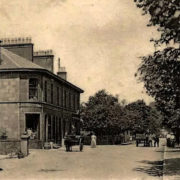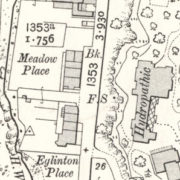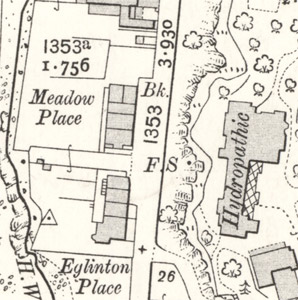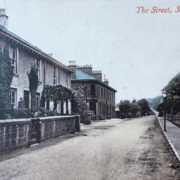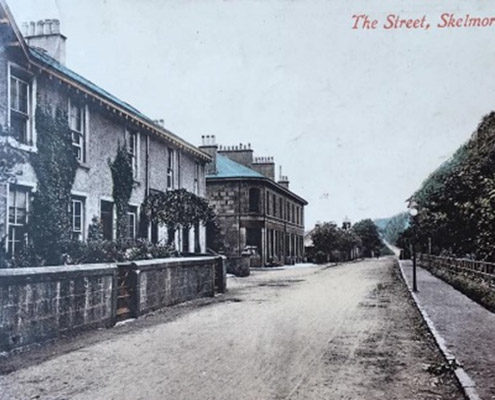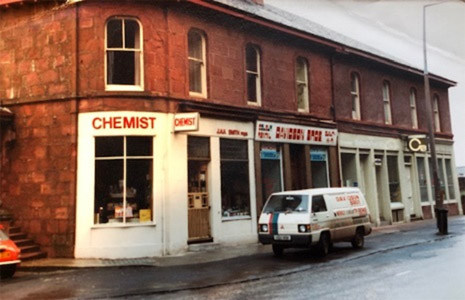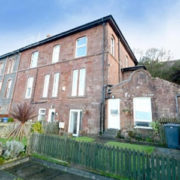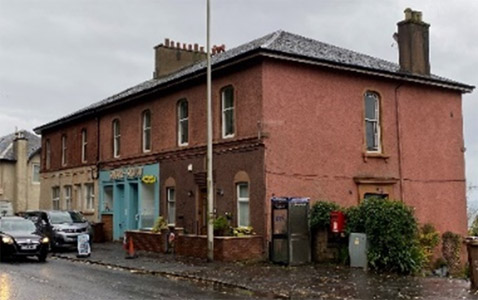52 – 58 Shore Road
Source of Photos: 1. & 2. Meadow Place Circa 1905 from facebook: Skelmorlie & Wemyss Bay in their heyday. 3. 1910 Ordinance Survey map. Meadow Place is situated on Shore, north of Eglinton Place. 4. Eglinton Place (in foreground) and Meadow Place (background), circa 1953 from facebook: Skelmorlie & Wemyss Bay in their heyday. 5. Looking east at Meadow Place (left), Eglinton Place (right) and the Hydro(above) – courtesy of Brian Spence 6. Meadow Place circa 1983 – courtesy of Brian Spence. 7. Meadow Place from SW – Corum sales brochure 2019. 8. Meadow Place from NE Oct. 20 – ND.
Background of the original owner
The story of Meadow Place starts with a Daniel Campbell.
Daniel Campbell was born in 1815 in Dunoon to John, a cattle dealer and Margaret (Clark) Campbell. In 1835, when he was 20, Daniel married 18 year-old Mary McDonald, daughter of Alexander McDonald, hotel keeper in Glasgow and Janet, nee Fleck. Children followed soon after with John in 1837, Janet in 1839, Alexander in 1841, Duncan in 1843, Margaret in 1847 and Mary in 1850. [1] [2]
In the 1841 census, the first to be retained by the National Records of Scotland, Daniel, then 25 was living at Meigle with Mary and the three eldest children. At the time, he cites his occupation as shoemaker and they have two visitors staying with them; a shoemaker and a young girl aged 10. [2.1]
Ten years later, the family are still living at Meigle. All of the children have now been born, with the youngest, Mary, just one year old. Daniel gives his occupation as master shoemaker and his 14 year old son, John, has also become a shoemaker. Janet, Alexander and Duncan are still at school. Again they have another shoemaker staying with them, this time a James Gallacher (jouneyman). Note: A journeyman is skilled in a given trade or craft and has successfully completed an official apprenticeship. [2.2] [3]
By 1855, we see that Daniel is renting a workshop at Springbank (a block of shops and houses on the seaward side of Shore Road, north of where Meadow Place will soon be built) and by the time of the 1861 census, he and the family have also moved to Springbank. We note that Daniel is no longer just a shoemaker, he has added grocer to his occupation. His son John is now a fully qualified (journeyman) shoemaker and is presumably working in his father’s workshop. Janet and Duncan are shopkeeper grocers. Whilst the census does not include commercial properties, we’re told that Daniel also occupies a shop and bakehouse at Springbank. [4] [2.3] [5]
The same census shows that there is now a building, called Pier Head situated between Halketburn (bottom of the Hydro steps) and Springbank. This building has 2 houses, (5 rooms each) and probably includes shops, although they’re not listed here. As one of the two families living there, are the Watson Family, it is probably safe to assume that this building will become Eglinton Place. [2.3]
In October 1863, the Earl of Eglinton and Winton assigned to Daniel Campbell “an area of ground to the west side of the public road, leading along the shore from Greenock to Largs” on the express condition that he should build in the space of two years, “two dwelling houses or blocks of building each of two storeys in height towards the public road, with two shops on the ground floor of each block and each of the said two dwelling houses or blocks to be forty feet or thereby in length fronting the said public road and each of not less value than £700 sterling”. There were two further conditions of relevance; the buildings must conform to the Plans and Elevations which have been prepared by William Railton, architect, (not of Nelson’s Column fame) and only the trades of a baker and shoemaker, may be carried out on the premises. [6]
The Daniel & Mary Campbell years (1865 – 1891)
By 1865, Meadow Place is finished and is wholly owned by Daniel Campbell. He and his family are living in one of the houses, a second house is occupied by an Alex McDonald and a house, shop and bake house are rented by a Mrs Stevens. [7.1]

Meadow Place 1865
The 1871 census tells us a bit more about the people. The building is still wholly owned by Daniel Campbell. There are three houses, each of six rooms (with one or more windows). [8.1]
In the first house, Charles Loudon, parcel deliverer, lives with his wife Ann Loudon, his 19 year old niece, Catherine McLean and his 16-year old nephew, James McLean. James also gives his occupation as parcel deliverer. The Loudons have two lodgers; William Hay, a policeman born in Inverness and Robert Cameron, a baker, born in Greenock. [8.1]
The second house, is home to Daniel Campbell and family. Daniel is now 56 and his occupation is grocer. Living with him is Mary his wife now 55, Janet now 31, Maggie 23 and Mary 21. The Campbells have one boarder, John Easton, 15, an apprentice baker. [8.1]
The third house is occupied by the Orrs. James Orr, aged 36, born in Ireland is a marine insurance broker. His wife Katherine, aged 24 was born in Bengal, India. They also have a daughter Katherine, aged 4, born in Glasgow. Living with them are two servants; Isabella McKellar, aged 22, cook/domestic servant and Agnes Johnston, aged 21, table maid. [8.1]
Daniel Campbell, had only about 7 years to enjoy his new house as he died at home in 1872, aged 58. Interestingly, his occupation on the death certificate reverts to shoemaker. The death is informed by his son, Alex Campbell. [1]
Following Daniel’s death, Meadow Place with all its properties, passes to his wife Mary, Liferentrix (a Scots Law term meaning a woman who enjoys the rent from a property for her life). By 1875, Mary Campbell, then aged 58 appears to be running a shop, the bake house as well as a shop on Skelmorlie Pier, presumably with the help of her family. Charles Loudon, who was previously renting one of the shops appears to have died and Mrs Loudon has taken over the house and shop. [7.2]

Meadow Place 1875
Six years later, in 1881, the Snodgrass family have taken over the lease from Mrs Loudon; John, aged 20, merchant and flour miller, his wife, Janetta, aged 22, his brother James, 29, also merchant and flour miller, his sister-in-law, 24, an accountant and a domestic, Margaret Smith. Around the same time, a Robert Cameron, his wife Margaret and young family have taken on the lease of the bake house, shop and house. Meanwhile, Mary Campbell continues to live in the third house with three of her now grown-up children; Duncan, 37 Iron Founder and Engineer, Maggie, 30 and Mary, 28, the latter both giving their occupations as Accountant. The Campbells also have a family of three visiting. Note: The number of rooms in the Campbells house has now increased from 5 to 8. [8.2]
By 1885, although the building continues to be held by Daniel’s Trustees on behalf of Mary, the configuration has changed to provide additional accomodation and shops. The Campbell family still live in one of the houses ( 8 rooms). A Robert Raphael has taken over the grocer’s shop and associated house. Jane Wilson, milliner, has a shop and one room house and Mrs Cameron, now widow, has taken on the lease of the bakehouse, shop and associated house (4 rooms). Additionally, there is now a shoemaker shop run by James McAulay, a fruiterer run by Michael Daly and one empty shop. Mrs Campbell continues to manage the coach house, stable and wash house. [7.3]
The 1891 census gives us a similar picture, apart from one of the houses is now rented by a Thomas Donald, Property Agent, his wife and young family. Four years later, the grocer has become a James Maxwell Parkhill and the Fruit Shop has gone. Instead, there are two new shops; one rented by a Dr David Fotheringham and a watchmaker’s shop, run by a Robert Paton. The stables have been split and are rented by the bake house and grocer. [8.3][7.4]
Further investigation shows that James Maxwell Parker, the new grocer, is actually related to the family through marriage. In April 1871, Janet, the eldest daughter of Daniel and Mary, married James Parkhill, commercial traveller, at the Established Church of Scotland in Skelmorlie. For the next 15 years or more, the couple appear to have lived in Greenock and had four daughters; Mary in 1874, Isabella in 1876, Jessie in 1878 and Margaret in 1883. At the time of the 1891 census, the family are living next door at 1 Eglinton Place, whilst renting the grocers shop at Meadow Place. [8.1][8.2][8.3][9]
Misses Margaret and Mary Campbell (1891 – 1940)
That same year, Mary (McDonald) Campbell, died at home, aged 79. Her son Duncan, by then living in Glasgow, was Informant. From looking at the next set of records, it appears that the whole building at Meadow Place was left to two of her daughters, Margaret & Mary Campbell. [1] [8.4]
By 1905, apart from the change of ownership to the Misses Campbells, much was the same at Meadow Place. Margaret and Mary were still living in one of the houses above the shops and the other two houses were let. James Parkhill, continues to run the grocer’s shop but now appears to be renting the associated house. Mrs Cameron is still at the bakery and James Macaulay continues to run the shoemaker. However, Mrs Lavinia Campbell, draper, appears to have taken over from Mrs Wilson, milliner and a Daniel McInnes, plumber has moved into the workshop and office. The big change however, is that Skelmorlie now has a bank, with the Clydesdale Bank opening offices at Meadow Place (north end) just after the turn of the century. [7.5]

Meadow Place 1905
Ten years later, the building at Meadow Place continues to be owned by Margaret and Mary Campbell and they still live in one of the upstairs flats. James Parkhill and family continue to run the grocer’s shop and are renting a house, office, stable and cellar space. Three of his daughters (Margaret and Mary’s nieces); Mary, Isabella and Jessie Parkhill, are renting one of the other houses. The drapers, bank and plumbers stay the same but the shop, bakehouse, house and stable have been taken over by John Ure Young who also has a bakery in Inverkip. [10.1]
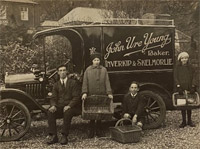
John Ure Young.
Around the end of WW1, the grocer’s shop was replaced by a chemist, with an Archibald Brownlie as dispenser. The Misses Campbells continue to own the property and stay in one of the houses, the Parkhill girls who are now in their early to mid forties, remain renting another of the houses and John Ure is still at the bakery. The other change is at the shomakers, where John Macaulay, is replaced firstly by a George Paterson, bootmaker and then a few years later by a Robert Davidson, bootmaker. [10.2][10.3]
Early, in 1930, Margaret Campbell died aged 77, leaving Meadow Place property to her sister, Mary. Over the next five years, there are the usual changes in tenancy. The Parkhill girls have moved on and are replaced by a Janet C Greaves, widow. At the chemist, William Brownlie, father of Archibald, who’d been the named tenant for the previous ten years, is replaced by Hugh Hutchison, who also rents a second house in the building. A Miss Jessie Reid takes over the draper’s shop, the plumber’s shop is taken over by Morrison and Scott and a space is taken by Ayr County Council for local storage of tools. The bank, bakery and bootmakers remain unchanged. [10.4][10.5][11]

Meadow Place 1935
In February 1936, Mary Campbell (daughter) then 86, also dies. With no children of their own, Meadow Place was left to Isabella Bennie Parkhill and others. The title deeds do not tell us who the ‘others’ are. [6]
In November 1938, Archibald McNicol Brownlie, 51, the original pharmacist, purchased the southern half of Meadow Place on the condition that the gable wall between the two basement flats was reinstated once the then lease expired. He in turn transferred part of the building; a shop, house and cellars to Jessie Reid, draper (the then tenant) who continued to run the shop and live there. [6]
We learn from the 1940 valuation roll, that Archibald Brownlie is renting out both houses in the southern block; one to Janet Grieve (widow) and the other to an Anthony McLeod, retired. Jessie still owns and is living in her shop/property and that the northern block is still in the hands of the trustees, presumably until they find a buyer. Of these properties, the bootmaker, tool house and bank continue to be rented and operate as before. The bakery, bake house and one of the workshops are empty. The flats & houses on that end of the building are all let. [10.6]
Living memory (1940 onwards)
Official records (valuation rolls) have not been released beyond 1940, so our story of Meadow Place now relies on the memories of some of our ‘locals’. [12]
We assume that the Clydesdale Bank bought the bank building and house/flat above, from the trustees. From 1939 until 1959, the house/flat was let to Mr and Mrs Peter Shepherd as the then bank manager, Mr Lennox lived locally in Wemyss Bay and didn’t require it. The Shepherds had three children; Matt, Bill and Frances. Bill and Frances (now Frances Nicol), still live in the village today. [12]
Mr Leonard Cummings became bank manager in the 1970s. He was an authority on Mount Stuart and retired to Rothesay around 1984. He was succeeded by Mr Peter Kelso, who retired in 1990. [12]
The Bank then became part-time until it finally closed in late 1990s. It was during this ‘part-time’ period, that two bank robberies occurred. [12] [13]
In April 1990, two armed robbers, stole £6,000 and escaped on a motor cycle. They were duly caught and received jail sentences in 1991. Less than two years later, on 20th February 1992, when the bank was staffed by three ladies, another intimidating robbery occurred. Two masked men, carrying a handgun and imitation shotgun, burst in, threatened the staff, jumped over the counter and stole in excess of £20,000. Barbara Redford, one of the staff members on duty at the time recalled “It was a very harrowing experience for the staff”. Fortunately, as before, the thieves were caught and prosecuted and the money recovered. [12] [13]
Jessie Reid, who’d bought the shop and house next door to the chemist, in 1938, continued to own both until she sold to the Davidson Brothers in 1960. In the intervening years, Jessie and her sister, moved with the times and transformed the outlet from draper in the 1930s, to what we are told was a “very fashionable, upmarket dress shop” when it closed. [12]
By 1982, Meadow Place essentially comprised two main houses occupying the first floor and attic of the building (one accessed from the south and the bank house/flat from the north), a basement/ garden flat accessed from the rear and four shops with storage and cellar space running the breadth of the building. The shops at the time, (south to north), were a pharmacy/chemist shop, a TV repair business (Davidson Brothers), a post office (run by the Farishes) and the Clydesdale Bank. [12]
That year, Mr Brian Spence bought the pharmacy and the house above, from the then pharmacist, Jeanette Smith. Approximately, a year later, he also purchased the Davidson’s shop and used the space to expand the pharmacy. [12]

Skelmorlie Post Office after Clydesdale Bank closure.
The chemist, post office and bank continued as the three outlets until the late 1990s when the local doctors decided to open an additional surgery in Wemyss Bay. In response, the Spences created two new shops; a pharmacy located in Ardgowan Road, Wemyss Bay and the Medical Hall in Upper Skelmorlie. The existing premises were converted into two houses at ground floor level and two garden flats, accessed from the rear. These together with his own house, first floor and the attic (which he’d converted some years before), were sold in 1999. [12]
After the Clydesdale closed, planning permission was granted to convert the bank building into 3 flats/houses. [12]
This just left the post ofice, which had been opened in 1940 in the old bakery premises. It continued in this form until Nov 2018 when it shut for the last time. Many assumed the premises would be converted into a resedential property but much to the delight of the village, instead it was purchased and reopened as a takeaway/sandwich shop “Shore Shack” in June of this year.
The story of Meadow Place started with Daniel Campbell. Today, his house, now 66 Shore Road, the first floor and attic in the southerly block, has 10 rooms compared to the 8 in 1881.

Cornice in lounge
The first floor comprises a large hall, 3 bedrooms, a bathroom (which was created from what was a fourth bedroom in 2001), a kitchen and lounge. All of these rooms have original cornicing but only one room still has a fireplace, which whilst in keeping, is not original to the property.
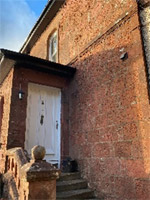
Access to 66 Shore Rd.
The current owner, Mr S McVey, has stripped back all woodwork on the doors, facings, skirtings and shutters throughout the first floor as well as removing the exterior centre mullions on two of the west-facing rooms to improve the light and views. [12]
There are currently 3 rooms in the attic, a bedroom, shower room and a lounge. The latter was created in 2007 from a bedroom and has dormer doors leading to a large glass balcony overlooking the Clyde. [12]
ND – November 2020
References and sources:
- Death certificates for Daniel Campbell & Mary (McDonald) Campbell., father
- 1: 1841 census. 2.2: 1851 census. 2.3 1861 census.
- Definition of Journeyman, Wikipedia.
- 1855 Valuation Roll for Largs in the county of Ayrshire.
- “Skelmorlie: The story of the parish consisting of Skelmorlie & Wemyss Bay”, Walter Smart 1968.
- Title Deeds for 66 Shore Road, the first and attic floor flat of Meadow Place, courtesy of Stuart McVey, current owner.
- 1 – 1865 Valuation Roll. 7.2 1875 Valuation Roll (VR). 7.3 – 1885 VR. 7.4 – 1895 VR. 7.5 – 1905 VR.
- 1 – 1871 census. 8.2 -1881 census. 8.3 – 1891 census. 8.4 – 1901 census.
- Marriage certificate for James Maxwell Parkhill and Janet Fleck Campbell.
- 1 – 1915 Valuation Roll (VR). 10.2 – 1920 VR. 10.3 – 1925 VR. 10.4 – 1930 VR. 10.5 – 1935 – VR. 10.6 – 1940 VR.
- Death certificates for Margaret Campbell and Mary Campbell.
- Information, memories and stories from Stuart McVey, Brian Spence, Frances Nicol, Bill Shepherd and Barbara Redford.
- “Three men charged after bank robbery” Largs and Millport Weekly News, February 28th 1992

